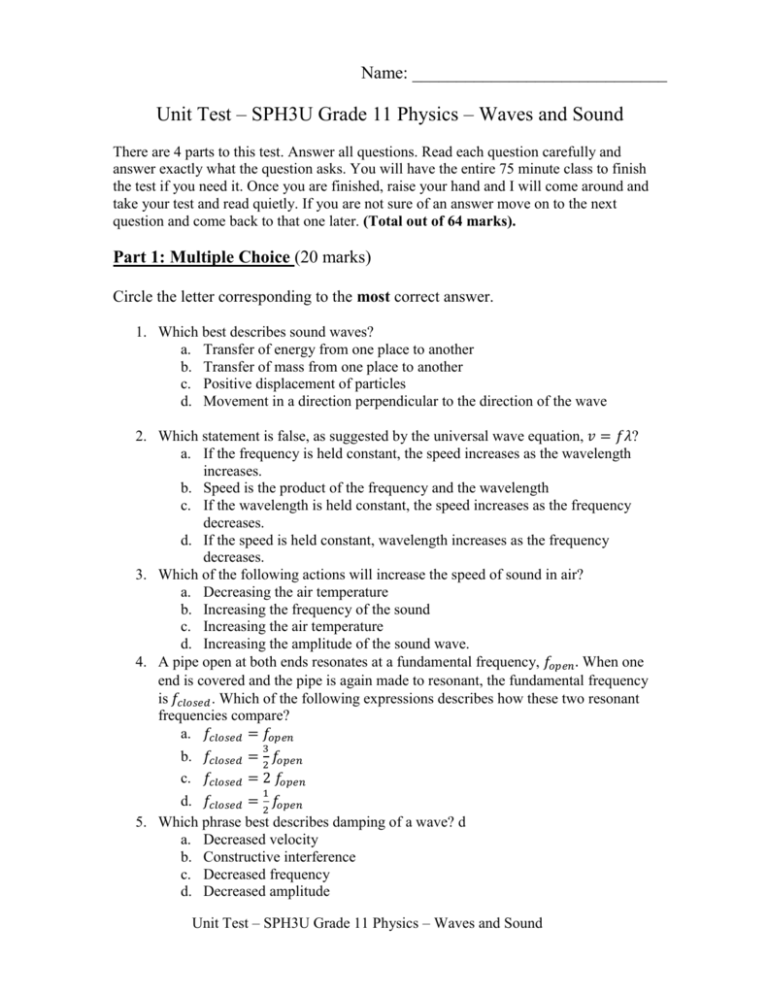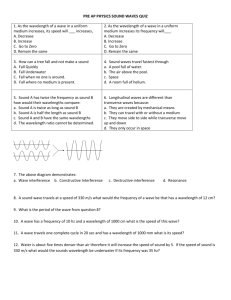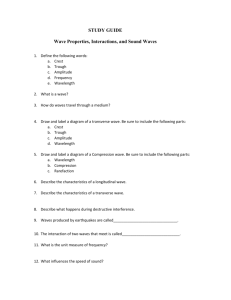Unit Test – SPH3U Grade 11 Physics – Waves and Sound
advertisement

Name: _____________________________ Unit Test – SPH3U Grade 11 Physics – Waves and Sound There are 4 parts to this test. Answer all questions. Read each question carefully and answer exactly what the question asks. You will have the entire 75 minute class to finish the test if you need it. Once you are finished, raise your hand and I will come around and take your test and read quietly. If you are not sure of an answer move on to the next question and come back to that one later. (Total out of 64 marks). Part 1: Multiple Choice (20 marks) Circle the letter corresponding to the most correct answer. 1. Which best describes sound waves? a. Transfer of energy from one place to another b. Transfer of mass from one place to another c. Positive displacement of particles d. Movement in a direction perpendicular to the direction of the wave 2. Which statement is false, as suggested by the universal wave equation, ? a. If the frequency is held constant, the speed increases as the wavelength increases. b. Speed is the product of the frequency and the wavelength c. If the wavelength is held constant, the speed increases as the frequency decreases. d. If the speed is held constant, wavelength increases as the frequency decreases. 3. Which of the following actions will increase the speed of sound in air? a. Decreasing the air temperature b. Increasing the frequency of the sound c. Increasing the air temperature d. Increasing the amplitude of the sound wave. 4. A pipe open at both ends resonates at a fundamental frequency, When one end is covered and the pipe is again made to resonant, the fundamental frequency is . Which of the following expressions describes how these two resonant frequencies compare? a. b. c. d. 5. Which phrase best describes damping of a wave? d a. Decreased velocity b. Constructive interference c. Decreased frequency d. Decreased amplitude Unit Test – SPH3U Grade 11 Physics – Waves and Sound 6. Which of the following is least likely to cause vibration in an aircraft? a. Engine operation b. Applying aerodynamic brakes c. Energy added to airflow around the wings is greater than energy lost d. Mass distribution Matching 7. __ First harmonic 8. __ Second harmonic 9. __ Seismic waves 10. __ Echolocation a) b) c) d) Earth exploration e) Bats hunting Part 2: Short Answer 1. In class we put music in a zip lock bag and then in and out of water, it sounded quitter and more muffled. Explain how it sounded and explain why it sounded the way it did. (Explain your answer) (4 marks) 2. When determining the speed of sound using a glass column, a column of water, and a tuning fork, we used 2 adjacent resonant points and found the difference in air column length between the 2 points. Why did we do this instead of just using 1 resonant point? (6 marks) Part 3: Problems 1. A large earthquake hits the Pacific Ocean near Japan. The time of the earthquake is 5:00 AM local time on Thursday August 15 in Los Angeles. The authorities estimate that the wavelength of the resulting tsunami will be approximately 200 km/hr; however the frequency of the wave is expected to be only 2 Hz. The site of the earthquake is 8000km from Los Angeles. There is a sand castle building contest scheduled for 2:00-4:00 PM local time on Thursday, August 15 at a beach near Los Angeles. Should they cancel the contest because of the coming tsunami or will they finish before the wave arrives? (7 marks) 2. The length of the “E” string on a guitar is 65 cm and it produces a sound with a frequency of 82.4 Hz. At what speed does the wave travel along the “E” string? (5 marks) Part 4: Essay/Diagram Questions 1. Using diagrams explain the theory behind the fact that the length of tube used in your closed-end panpipes was determined by the formula: Unit Test – SPH3U Grade 11 Physics – Waves and Sound Length of pipe = ¼ * wavelength (8 marks) 2. Two (2) pebbles are dropped in a quiet lake. Draw the resulting wave patterns developed using concentric circles around the 2 points of impact. Assume that the lines are the crests of the waves and the dotted lines between the lines are the troughs. Indicate three (3) locations where constructive interference is occurring and three (3) locations where destructive interference is occurring. Label your areas “C” for constructive and “D” for destructive. (6 marks) 3. Give 1 example of constructive interference and 1 example of destructive interference of waves in action and briefly explain how the phenomenon is used in society. Choose one of them and explain if it is beneficial to society or detrimental. (8 marks) Unit Test – SPH3U Grade 11 Physics – Waves and Sound Unit Test – SPH3U Grade 11 Physics – Waves and Sound Answer Guide Part 1: Multiple Choice (K, U) Circle the letter corresponding to the most correct answer. 2 marks for each correct answer – total of 20 marks. 11. Which best describes sound waves? a. Transfer of energy from one place to another b. Transfer of mass from one place to another c. Positive displacement of particles d. Movement in a direction perpendicular to the direction of the wave 12. Which statement is false, as suggested by the universal wave equation, ? a. If the frequency is held constant, the speed increases as the wavelength increases. b. Speed is the product of the frequency and the wavelength c. If the wavelength is held constant, the speed increases as the frequency decreases. d. If the speed is held constant, wavelength increases as the frequency decreases. 13. Which of the following actions will increase the speed of sound in air? a. Decreasing the air temperature b. Increasing the frequency of the sound c. Increasing the air temperature d. Increasing the amplitude of the sound wave. 14. A pipe open at both ends resonates at a fundamental frequency, When one end is covered and the pipe is again mede to resonant, the fundamental frequency is . Which of the following expressions describes how these two resonant frequencies compare? a. b. c. d. 15. Which phrase best describes damping of a wave? a. Decreased velocity b. Constructive interference c. Decreased frequency d. Decreased amplitude 16. Which of the following is least likely to cause vibration in an aircraft? a. Engine operation b. Applying aerodynamic brakes c. Energy added to airflow around the wings is greater than energy lost d. Mass distribution Unit Test – SPH3U Grade 11 Physics – Waves and Sound Matching 17. b_ First harmonic 18. c_ Second harmonic 19. e_ Seismic waves 20. d_ Echolocation a) b) c) d) Bats hunting e) Earth exploration Part 2: Short Answer 1. In class we put music in a zip lock bag and then in and out of water, it sounded quitter and more muffled. Explain how it sounded and explain why it sounded the way it did. (Explain your answer) (C, A) 4 marks A. As the sound waves entered the water they were then given three mediums to pass through 2 C marks (the air in the bag, the water, and the air we could hear from). Due to passing through mediums, 1 A mark there is a chance that the wave can get reflected when it hits a new medium. 1 A mark The amplitude will also be much smaller thus affecting sound volume. (Chapter 9.2 Physics 11 University Preparation Textbook ) 2. When determining the speed of sound using a glass column, a column of water, and a tuning fork, we used 2 adjacent resonant points and found the difference in air column length between the 2 points. Why did we do this instead of just using 1 resonant point? (C, T/I) 6 marks A. 3 C marks →The actual length of the wave inside the tube is a little bit longer than ¼ the length of the air column because of the fact that the antinode at the end of the tube lies slightly beyond the tube itself. 2 T/I marks→ By subtracting the 2 adjacent points we are left with a distance that equals exactly ½ the length of the wavelength that was set up in the tube. 1 T/I mark →This means we do not have to worry about how far the sound wave extends beyond the tube. Part 3: Problems (K/U, C, A) 1. Background: A large earthquake hits the Pacific Ocean near Japan. The time of the earthquake is 5:00 AM local time on Thursday August 15 in Los Angeles. The authorities estimate that the wavelength of the resulting tsunami will be approximately 300 km/hr; however the frequency of the wave is expected to be only 2 Hz. The site of the earthquake is 8000km from Los Angeles. There is a sand castle building contest scheduled for 2:004:00 PM local time on Thursday August 15 at a beach near Los Angeles. Should they cancel the contest because of the coming tsunami or will they finish before the wave arrives? (7 marks) A. 300 km/hr = 300 * 1000 / 3600 = 83.3 m/s 1 K/U mark V=f*λ 1 K/U marks Unit Test – SPH3U Grade 11 Physics – Waves and Sound V = 2Hz * 83.3 m/s V = 167 m/s V = 167 * 3600 / 1000 = 600 km/hr 1 K/U mark The wave is travelling at 400km/hr toward Los Angeles 1 A mark 8000 km/ 600 km/hr = 13.3 hrs to reach Los Angeles 1 A mark The wave will reach the Los Angeles beach at 5am + 13.3 hours = 6:18pm local time. The contest should not be cancelled because it will hit at 6:18 pm, 2 hours after the contest finishes, but participants should be warned. 2 C marks 2. The length of the “E” string on a guitar is 65 cm and it produces a sound with a frequency of 82.4 Hz. At what speed does the wave travel along the “E” string? (5 marks) For a vibrating string: λ = 2 * the length of the string 2 A marks λ = 2 * 0.65 = 1.3 m V= f * λ 1 K/U mark V = 82.4 Hz * 1.3 m V = 107.1 m/s 1 K/U mark The wave travels along the string at 107.1 m/s. 1 C mark Part 3: Essay/Diagram Questions (K/ U, C, A) 1. Using diagrams explain the theory behind the fact that the length of tube used in your closed-end panpipes was determined by the formula: Length of pipe = ¼ * wavelength (use the first harmonic in your explanation). (8 marks) A. Node 2 marks – including diagram and labelling Antinode First Harmonic in a closed tube. 3 C marks for the explanation The distance between adjacent antinodes on a standing wave pattern is equivalent to onehalf of a wavelength. Since nodes always lie midway in between the antinodes, the distance between an antinode and a node must be equivalent to one-fourth of a wavelength. Thus, the length of the air column is equal to one-fourth of the wavelength for the first harmonic as shown below. 3 K/U marks for this type of diagram properly labelled Unit Test – SPH3U Grade 11 Physics – Waves and Sound Length of closed pipe vs. total wavelength Therefore the length of pipe = ¼ * wavelength of the tube. 2. Two (2) pebbles are dropped in a quiet lake. Draw the resulting wave patterns developed using concentric circles around the 2 points of impact. Assume that the lines are the crests of the waves and the spaces between the lines are the troughs. Indicate three (3) locations where constructive interference is occurring and three (3) locations where destructive interference is occurring. Label your areas “C” for constructive and “D” for destructive. 6 K.U marks – (for correct location of C’s and D’s). (C, K/U, T/I) D C C C D D 3. Give 1 example of constructive interference and 1 example of destructive interference of waves in action and briefly explain how the phenomenon is used in society. 6 marks – (1 C for each example, 4 A for the explanation) (C, A) Answers may vary. Examples: Musical Instruments playing in tune - constructive Concert halls built to amplify sounds - constructive Sound control systems in factories producing out of phase sounds to muffle machinery noise – destructive Masses and extra beams added to bridges to change their natural resonant frequencies so that they will exhibit destructive interference with the vibrations set up by winds – destructive. Unit Test – SPH3U Grade 11 Physics – Waves and Sound








